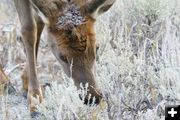

Elk Calf
Critics say that a faulty federal elk feeding program resulted in too many elk calves starving to death last winter. Photo by Cat Urbigkit.
|


Bull Elk
Bull elk lounging on the National Elk Refuge in Jackson. Photo by Cat Urbigkit.
|
|
Hay Day event slated for refuge elk Dec 9
Helping wintering elk in Jackson Hole
by Cat Urbigkit
December 1, 2006
On Saturday, December 9, trucks hauling loads of donated hay will roll into the Teton County Fairgrounds in Jackson as sportsmen take action to ensure that elk wintering on the National Elk Refuge do not die of starvation before spring arrives.
The Hay Day event is sponsored by Sportsmen for Fish and Wildlife and will occur just hours before the organization hosts its annual banquet and convention at the Snow King Resort Ice Arena.
SFW Executive Director Bob Wharff said his organization decided to take action after last winter’s feeding program. According to Wharff, at least 25 percent of elk calves on the refuge died during the winter. For comparison, the elk calf mortality rate on state-managed elk feedgrounds is just three percent.
The U.S. Fish and Wildlife Service manages the elk refuge and usually begins supplemental feeding of elk in January, in recent years to about 5,000 elk.
The elk are fed alfalfa pellets which measure 5/8 – 3/4” in diameter x 2” long and are high in protein. The feed is placed so that there are about seven to eight pounds of pellets per elk per day, depending on conditions. The National Elk Refuge conducts the feeding, furnishes the equipment and shares equally in the cost of the pellets through a cooperative agreement with the Wyoming Game and Fish Department. Presently, it costs an average of $2,720 per day to feed 20 tons of alfalfa pellets to 5,000 elk, bringing feed costs to approximately $200,000 each year, or $40 per elk. The elk are fed alfalfa pellets an average of 75 days each winter.
Refuge managers also provide feed for the expanding bison population on the refuge, with about 945 bison wintering on the National Elk Refuge. The Jackson bison herd has been growing 10-14 percent each year since 1990. Bison impact the supplemental feeding program by consuming an additional 700 tons of feed per season, totaling approximately $97,000, according to information provided by FWS.
Elk are on the refuge for about six months each year from November to May, free- ranging for about 3.5 months and using supplemental feed for about 2.5 months, usually from late January until April, according to FWS. When deep or crusted snow prevents the elk from grazing, or the natural forage is depleted, refuge personnel feed the herds pelletized alfalfa.
Refuge managers begin regular surveys of conditions each December to determine the need for supplemental feeding. Sampling focuses on forage availability and utilization by the herd as well as snow depths and consistency. When conditions make it difficult for the elk to obtain natural forage, the feeding program is initiated. Supplemental feeding usually starts in late January on the years it is provided but can vary depending on conditions and the number of elk on the refuge.
According to FWS, during an average winter, approximately 60 percent of the food requirements of the wintering elk herd are met by standing forage and 40 percent by supplemental feed.
But SFW asserts that last year, refuge managers didn’t respond to changing conditions that left the elk with little to eat. Rather than providing supplemental feed, the elk were relying exclusively on the pellets. Wharff said that in addition, refuge managers grossly underestimated the number of elk that were being fed, so not enough feed was being made available to the elk.
Wharff also maintains that while the hay pellets fed on the refuge are a great source of protein, elk need a complete diet, including roughage. When elk can’t get the roughage from standing forage, due to ice or snow conditions, they need to be fed hay to fill their guts and keep their natural digestive processes working.
With the hay delivery, Wharff said, “We’re ensuring we don’t repeat the same event again. The reality is elk were starved.”
Donate:
Anyone wanting to donate hay or support the Hay Day event is encouraged to call SFW vice executive director David Bush of Cheyenne at 307-630-0572. All hay must be certified weed free. Volunteers are also needed to unload the hay at the refuge after a 2:00 p.m. press conference at the fairgrounds in Jackson.
National Elk Refuge facts:
• In the early 1900s, severe winters with deep, crusted snow also took a serious toll on the wintering elk in the Jackson region. The refuge was created in 1912 as a result of public interest in the survival of the Jackson elk herd.
• Elk stay on the refuge for approximately six months each winter. An 8-foot high fence along the main highway and the northern border of town prevents elk from moving through Jackson and onto private lands.
• The Jackson elk herd was used as a nucleus herd to replenish other elk herds and elk re-introductions across the country.
• The migration of the Jackson Hole Elk is the longest herd migration of elk in lower U.S.
• It is winter range for the largest bison herd (more than 900) in the National Wildlife Refuge System.
• It is the world's largest wintering concentration of elk with national and international significance.
Story and photos by Cat Urbigkit
|

